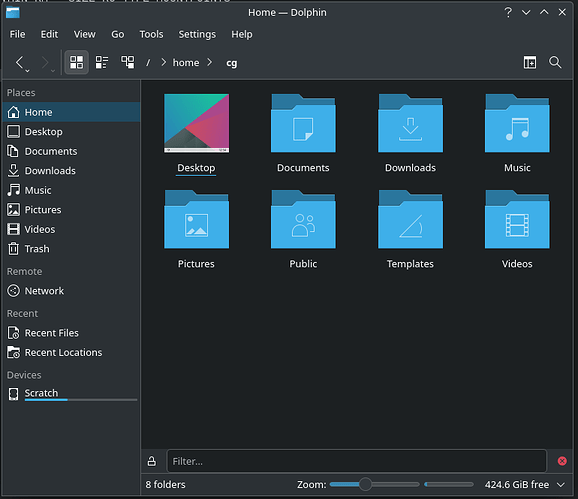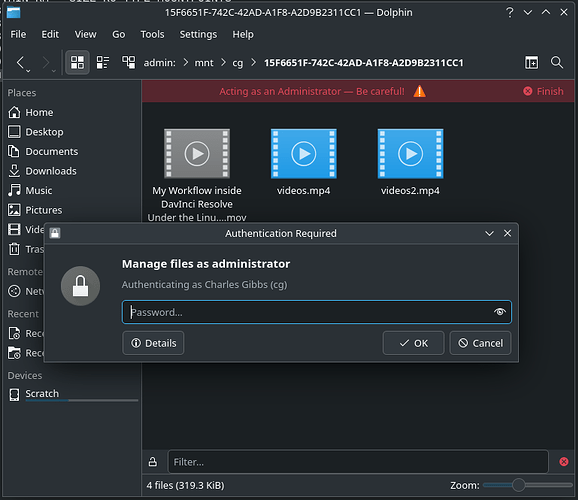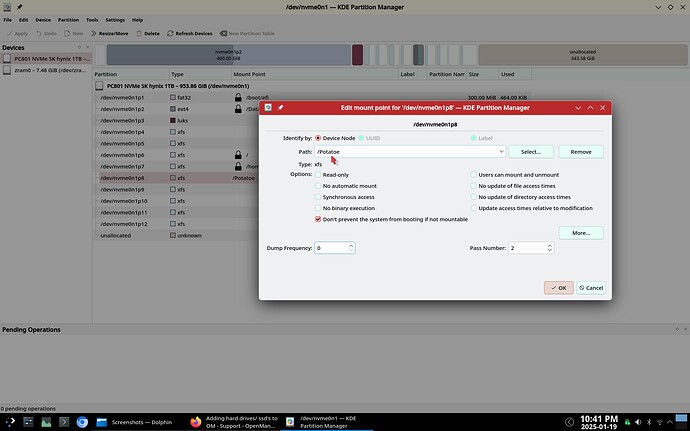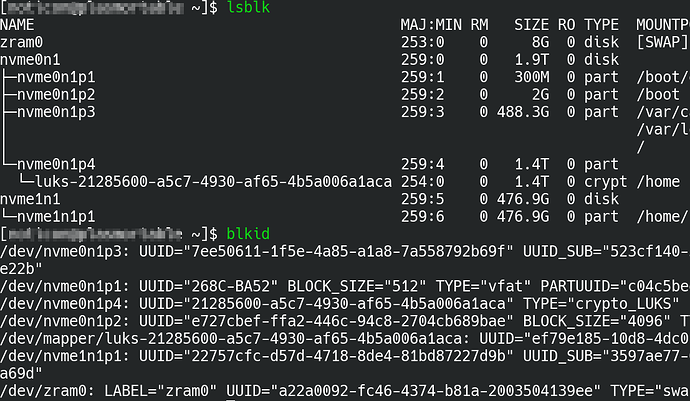Well in the old days I was teached to update grub every time you make changes there. I still do.
Actually needed? not sure but won’t hurt either ![]()
If you alter the fstab it’s better to test it before rebooting, you can use
sudo mount -a
this will try to mount eveything in the fstab if there are no errors check to see is if the new drive is mounted if so you should be ok to reboot, if it throws up any errors fix them before rebooting. Also it’s good practice to make a copy before altering
sudo cp /etc/fstab /etc/fstab.bak
this way if things really go pair shaped you can restore the original from a live usb
sudo cp /etc/fstab.bak /etc/fstab.
sudo chown -R myid:myid FOLDER
I’m pretty sure you can just run:
sudo chown -R $USER:$USER FOLDER
You’re right, it would. When I wrote that earlier, I was worried that using the variable option here may implement root. But I was wrong. I just double checked in the terminal.
Hi Ben.
SO, I think I must have messed something up earlier with the mount point.
I have successfully mounted the drive @ /mnt/cg/15F6651F-742C-42AD-A1F8-A2D9B2311CC1
To use chown I unmounted the drive and typed the following:
sudo chown -R cg:cg /mnt/cg/15F6651F-742C-42AD-A1F8-A2D9B2311CC1
After that I was brought back to the prompt,
when I restarted my PC the drive shows up and shows it is mounted, when I click on it to access it I am still prompted for my password? Is this what you were referring to as a bug?
If I click away say to documents or desktop and come back I am still prompted to click on the “Act as Administrator” button.
Let me know if this is the behavior you are referring to as the bug..
I unfortunately have to go to bed now early start tomorrow.
Regards C
Thanks for the Tip Rich hope I remember that next time.
Charles, can you show us what your /etc/fstab looks like?
Im totaly shooting in a dark here
- I assume you talk about internal drives not usb sata / ssd drives
If condition 1 is true then
If you want to have those drives accessible at al times add them to fstab
else use auto-mount that is provided in dolphin.
Relevant question
What file system is set on those drives if it is ntfs or exfat
you probably should use
fsck.exfat -r /dev/sdXY
or
Use the command fsck.ntfs -n /dev/sdXY to check the NTFS partition without making any changes, or fsck.ntfs -a /dev/sdXY to automatically fix any problems found.
Reading relevant man pages is highly advisable
If driveds are in some linux format in exampe ext4
You probably should do the same
and then regardles the filesystem go with
chown -R user:group /path/to/directory
To make it more simple
console
whoami enter will give you the name of current user
main is grafi
now if you put groups in to console that will give you all groups that your user belongs to
grafi lp wheel audio video users lpadmin network storage sambashare
Now if you want to give acces those drives to all human users of your pc
command will look like
sudo chown -R grafi : users /path/to/directory
If you want to give access only to your user
sudo chown -R grafi : grafi /path/to/directory
That should be it
ps fsck is used to reset sticky bits and file system errors
If its a fstab issue that is another story.
all above is relevant for acl or access rights
I had removed my examples because I did not think you were going that way and I did not want to confuse anyone later, but since you are going the /etc/fastab route, here are my examples for simple mounts, but no shares involved.
# Created Jan 18, 2025 by Wilson Phillips
#
# Use 'blkid' to print the universally unique identifier for a device; this may
# be used with UUID= as a more robust way to name devices that works even if
# disks are added and removed. See fstab(5).
#
# <file system> <mount point> <type> <options> <dump> <pass>
# /dev/nvme2n1
UUID=B57B-8282 /boot/efi vfat defaults,noatime,umask=0077 0 2
UUID=67df3832-6163-4468-b2cc-1d7f3d2970f4 / btrfs subvol=/@,defaults,noatime,compress=zstd:1,autodefrag 0 0
UUID=67df3832-6163-4468-b2cc-1d7f3d2970f4 /boot btrfs subvol=/@boot,defaults,noatime,compress=zstd:1,autodefrag 0 0
UUID=67df3832-6163-4468-b2cc-1d7f3d2970f4 /home btrfs subvol=/@home,defaults,noatime,compress=zstd:1,autodefrag 0 0
UUID=67df3832-6163-4468-b2cc-1d7f3d2970f4 /var/cache btrfs subvol=/@cache,defaults,noatime,compress=zstd:1,autodefrag 0 0
UUID=67df3832-6163-4468-b2cc-1d7f3d2970f4 /var/log btrfs subvol=/@log,defaults,noatime,compress=zstd:1,autodefrag 0 0
UUID=67df3832-6163-4468-b2cc-1d7f3d2970f4 /swap btrfs subvol=/@swap,defaults,noatime 0 0
/swap/swapfile swap swap defaults 0 0
tmpfs /tmp tmpfs defaults,noatime,mode=1777 0 0
#
#
# /dev/nvme1n1
UUID=c9cf5f3d-fee4-4624-a25c-15b5956c1e54 /backup1 ext4 user,data=ordered 0 2
# /dev/nvme0n1
UUID=deb53991-cd51-41d3-a075-4d6a459f8f04 /backup2 ext4 user,data=ordered 0 2
#
#
# /dev/sda1 SSD 4,000 GB (Fast)
UUID=0840328c-82a8-4124-b1e8-8438c06c50c2 /4TB-SSD1 ext4 user,data=ordered 0 2
# /dev/sdb1 SSD 4,000 GB (Fast)
UUID=5fb315f7-a721-4854-844e-5f19b905f740 /4TB-SSD2 ext4 user,data=ordered 0 2
#
#
# /dev/sdc1 HHD 4,000 GB (Slow)
UUID=a89fa57b-f843-44d6-a135-e095946f998e /4TB-HDD ext4 user,data=ordered 0 2
#
Where is automount in Dolphin, I am not finding this.
I made a stupid mistake. In KDE Partition Manager I was setting the mount point with the device name like /dev/nvme0n1p8 . Wrong >>> If you just select the device you want to mount and for mount point add a name like /Potato and click OK it works here.
So I believe there is only one bug now. The KDE Partition Manager should allow user to use UUID instead of Device Node.
But doing as I did here results in a mounted partition that opens in Dolphin without any Knights of Columbus handshake. It is easy.
Edit: Good help is hard to find…
Well, you can always take a look in lsblk and look at the /dev/x to see the UUIDs and then edit the fstab to mount them that way. Knowing the folks at KDE, they are working on it.
Let me rephrase that (my crappy english works against me)
What i mean by that was right click (on drive) mount in drop down menu appeared on the drive dolphin
I’m a little confused. In my use of KDE Partition Manager just a couple days ago, I had no issue using UUID to set the drive. All options were available to me to identify the device. Maybe @CharlesGibbsNam’s setup works with UUID?
@WilsonPhillips to identify UUIDs, you’d need to use blkid with sudo
I can see UUIDs with blkid or with lsblk.
┌──[wilson@heisenberg] Mon Jan 20, 07:38:01 [~]
└──[ <$> sudo blkid
[sudo] password for wilson:
/dev/nvme0n1p1: LABEL="/backup1" UUID="c9cf5f3d-fee4-4624-a25c-15b5956c1e54" BLOCK_SIZE="4096" TYPE="ext4" PARTUUID="7ef34acc-ba56-4b87-92dd-248bf500ae42"
/dev/sdb1: LABEL="4TB-SSD2" UUID="5fb315f7-a721-4854-844e-5f19b905f740" BLOCK_SIZE="4096" TYPE="ext4" PARTUUID="50b5ad44-0f84-47eb-89b1-71b16d1ed6e5"
/dev/nvme2n1p2: UUID="67df3832-6163-4468-b2cc-1d7f3d2970f4" UUID_SUB="fa8f1ccc-bfaa-4a2e-b433-caca84ed6ff3" BLOCK_SIZE="4096" TYPE="btrfs" PARTLABEL="root" PARTUUID="c79c6d60-1000-4bc0-be47-a1d867582e0d"
/dev/nvme2n1p1: UUID="B57B-8282" BLOCK_SIZE="512" TYPE="vfat" PARTLABEL="EFI" PARTUUID="50b1a95b-ba6c-45a3-9645-4da5a40c401a"
/dev/sdc1: LABEL="4TB-HDD" UUID="a89fa57b-f843-44d6-a135-e095946f998e" BLOCK_SIZE="4096" TYPE="ext4" PARTUUID="fda183db-379c-0646-807e-0d296a18ea6b"
/dev/nvme1n1p1: LABEL="/backup2" UUID="deb53991-cd51-41d3-a075-4d6a459f8f04" BLOCK_SIZE="4096" TYPE="ext4" PARTUUID="a8553c00-7d83-471b-a1d5-cf4a89c6f056"
/dev/sda1: LABEL="4TB-SSD1" UUID="0840328c-82a8-4124-b1e8-8438c06c50c2" BLOCK_SIZE="4096" TYPE="ext4" PARTUUID="9fb960cc-46b2-4fc6-a706-35ac4709eb9f"
/dev/zram0: LABEL="zram0" UUID="e656653d-0bfe-4c60-9c52-2b2d1df1ef49" TYPE="swap"
┌──[wilson@heisenberg] Mon Jan 20, 07:38:14 [~]
└──[ <$> lsblk
PATH LABEL UUID FSTYPE
/dev/sda
/dev/sda1 4TB-SSD1 0840328c-82a8-4124-b1e8-8438c06c50c2 ext4
/dev/sdb
/dev/sdb1 4TB-SSD2 5fb315f7-a721-4854-844e-5f19b905f740 ext4
/dev/sdc
/dev/sdc1 4TB-HDD a89fa57b-f843-44d6-a135-e095946f998e ext4
/dev/zram0 zram0 e656653d-0bfe-4c60-9c52-2b2d1df1ef49 swap
/dev/nvme1n1
/dev/nvme1n1p1 /backup2 deb53991-cd51-41d3-a075-4d6a459f8f04 ext4
/dev/nvme0n1
/dev/nvme0n1p1 /backup1 c9cf5f3d-fee4-4624-a25c-15b5956c1e54 ext4
/dev/nvme2n1
/dev/nvme2n1p1 B57B-8282 vfat
/dev/nvme2n1p2 67df3832-6163-4468-b2cc-1d7f3d2970f4 btrfs
One is easier to get what I need.
I forgot that I use an alias with some flags for lsblk. I noticed when I saw yours.
alias lsblk=‘lsblk -o path,label,uuid,fstype’
That’s helpful! And good to know. Thank you.
lsblk has a lot of flags that you can use.
I was thinking about it when I was shaving. I don’t remember when I set that alias up, but it was so long ago that I forgot what the standard output looked like till I saw yours. ![]()







